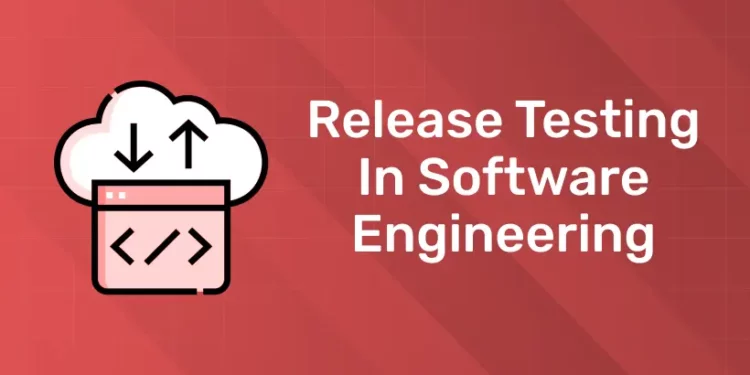Table of Contents
In the field of software development, release testing is one of the most important stages in the product delivery process. Release testing guarantees that the final version of a software product or application is distributed without errors. A release is the dissemination of the final version. Coding techniques and testing methods are used in release testing to make sure software applications are prepared for end users. Prior to shipping, it seeks to find and fix mistakes and defects in software products. As software products get more sophisticated, release testing has become crucial to ensuring that updates and new features are implemented with confidence and don’t negatively affect the end-user experience. In this blog post will explain release testing, its significance, and how it guarantees the delivery of high-quality software.
Learn Coding in your Language! Enroll Here!
What is Release Testing In Software Engineering?
A software application is systematically assessed through release testing prior to being made available in a production setting. A smooth user experience, stability, and compliance with all functional and non-functional requirements are the main objectives.
This stage of testing serves as a validation procedure to verify that the program satisfies business requirements and can manage real-world situations. Prior to deployment, it is frequently carried out following integration testing.
Importance Of Release Testing
1: What is software testing?
It becomes more expensive and time-consuming to address problems with software once it is in production. Release testing is important for the following reasons:
- It helps to identify defects that may have slipped through earlier testing phases.
- Verifies that the application performs consistently under expected conditions.
- Confirms that the software meets all functional and non-functional requirements.
- Ensures that the application behaves as intended and provides a satisfactory user experience.
Types Of Release Testing
Several testing techniques are used in release testing to make sure the program is prepared for deployment. Each type ensures the software’s quality, performance, and dependability by addressing particular parts of it. The various types of release testing are given below.
Functional Testing
This ensures that the software behaves as expected and meets all functional requirements.
- Objective: Validate features and functionalities.
- Example: Testing the login process with valid and invalid credentials.
Non-Functional Testing
This focuses on testing aspects like performance, usability, scalability, and security.
- Objective: Ensure the software performs well under various conditions.
- Example: Measuring response times during peak traffic.
Regression Testing
Ensures that recent changes, bug fixes, or updates haven’t introduced new issues.
- Objective: Verify the stability of the application after modifications.
- Example: Re-testing features after adding new functionality.
User Acceptance Testing (UAT)
Real users or stakeholders validate the software to ensure it meets business needs and expectations.
- Objective: Gain approval from end-users before release.
- Example: A client testing an e-commerce site to ensure it meets their specifications.
Smoke Testing
A quick round of tests to verify that the critical functionalities of the software are working.
- Objective: Ensure the stability of the software build.
- Example: Checking if the application launches and key features like search or login work.
Performance Testing
Evaluates the system’s speed, responsiveness, and stability under a specific workload.
- Objective: Ensure the application performs well under different conditions.
- Example: Testing how the system handles 1,000 simultaneous users.
Security Testing
Identifies vulnerabilities and ensures that the software is secure from potential threats.
- Objective: Protect sensitive data and prevent unauthorized access.
- Example: Testing for SQL injection or cross-site scripting vulnerabilities.
Compatibility Testing
Checks how the software performs across different environments, devices, browsers, or operating systems.
- Objective: Ensure the application works seamlessly in all supported environments.
- Example: Verifying a web application on Chrome, Firefox, and Safari.
Installation Testing
Validates that the software can be installed and configured correctly in the target environment.
- Objective: Ensure the installation process is smooth and error-free.
- Example: Testing an application’s installer on Windows and macOS.
Beta Testing
Real users test the software in a production-like environment before the final release.
- Objective: Get feedback from actual users and identify issues.
- Example: A limited group of users testing a new mobile app version.
Load Testing
Simulates heavy user traffic to check the software’s behavior under load.
- Objective: Measure the system’s capacity and performance.
- Example: Testing an online store during a sales event.
End-to-End Testing
Validates the complete workflow of the application from start to finish.
- Objective: Ensure all integrated components work together.
- Example: Testing an order placement process from login to payment confirmation.
Recovery Testing
Tests the software’s ability to recover from failures, such as power outages or crashes.
- Objective: Verify system reliability during unexpected events.
- Example: Testing database recovery after a server crash.
Usability Testing
Checks if the application is easy to use and provides a good user experience.
- Objective: Ensure user satisfaction.
- Example: Testing the navigation and readability of a mobile app.
Configuration Testing
Verifies the application’s performance with different hardware, software, and network configurations.
- Objective: Ensure compatibility and adaptability.
- Example: Testing an application on devices with varying RAM sizes.
Learn Software Testing from QA Experts! Get Free Demo Classes Here!
Advantages Of Release Testing
- Enhances the functionality and quality of software products
- Enhances the effectiveness of teamwork
- Reduces the risk
- Reasonably priced
- Enhances client satisfaction
- Improved project management
Phases Of Release Testing
There are two phases for release testing. They are:
- Pre Release Test
- Post Release Test
Pre Release Test
Prior to the software being made available to end users, it is conducted. In the release test environment, it is carried out. It includes putting the software through a rigorous testing process to find and correct bugs, make sure it satisfies quality standards, and confirm that it works as intended.
Post Release Test
It happens after the software has been made available to end users and put into use. The goal is to track the software’s performance in real-world settings and spot any potential problems after the product is released.
How To Do Release Testing?
- Make a thorough test plan that includes a timeline, specific test objectives, and goals.
- Establish the product release’s acceptance criteria.Make sure the testing environment is suitable and resembles the production environment.
- Assemble the different test data that will be utilized in the testing.All potential user scenarios should be covered by the test cases you plan and create.
- Monitor the test results after running the tests manually or using automated testing tools.
- Effective defect management aids in tracking and managing flaws discovered during testing, as well as prioritizing and promptly resolving them.
- Compile the test findings into a thorough report that includes the test cases that were run, the flaws that were discovered, and the product’s current state.
- Depending on the test results, determine whether the product is prepared for release or if further testing is required.
Challenges In Release Testing
Tight Deadlines: There is little time for comprehensive validation because testing frequently occurs late in the development cycle.
Complex Scenarios: Because real-world situations can be so intricate, it can be difficult to address every possibility that could arise.
Coordination: It can be challenging to guarantee smooth cooperation between the operations, QA, and development teams.
Modern Release Testing
A simplified and automated method of confirming software before it is deployed is modern release testing. It focuses on using techniques and methods that encourage speed, efficiency, and dependability to seamlessly include testing into the software development lifecycle (SDLC). The key features of modern release testing are given below.
- Modern release testing will enhance speed, teamwork, and continuous delivery when incorporated into an Agile and DevOps development process.
- By testing in production, modern release tests make it simple to find and address problems before they become serious.
- Since automated testing increases efficiency and decreases manual labor, it is essential to contemporary release testing.
- Modern release tests that make use of cloud computing and virtualization technologies will contribute to the development of test environments that are scalable, adaptable, and economical.
- In order to increase the effectiveness and quality of testing, it may automate difficult test tasks using AI/ML (Artificial Intelligence/Machine Learning) technology.
CONCLUSION
For end users to receive high-quality software, release testing is essential. It serves as a safeguard, guaranteeing that the program fulfills requirements, operates dependably, and offers an excellent user experience. Companies may guarantee a successful and seamless release by integrating different testing methods and adhering to best practices.
Learn Coding in your Language! Enroll Here!
Frequently Asked Questions
Why is release testing important?
It ensures that the software is stable, reliable, and free of critical bugs before being released to users. This step helps maintain user trust and minimizes post-release issues.
Who performs release testing?
Release testing is typically performed by a dedicated Quality Assurance (QA) team or a release team. It may also involve end-users for beta testing.
How is release testing different from system testing?
System testing focuses on testing the software as a whole to ensure it meets requirements. Release testing, on the other hand, focuses specifically on whether the software is ready for deployment in the real-world environment.
How do you handle failed tests during release testing?
If a test fails, the issue is logged and sent back to the development team for fixing. After the fix, the software is re-tested until all critical issues are resolved.












